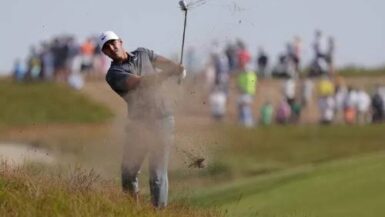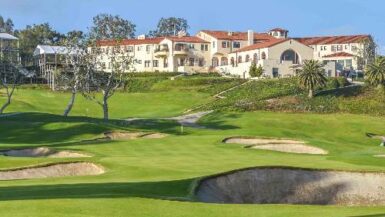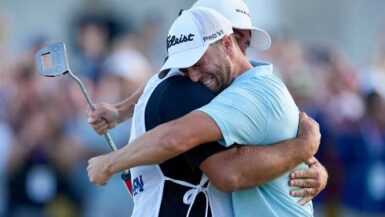OAKMONT, PA – No matter what side of the pond the speaker was from, the reaction was the same: “Padraig Harrington said what?!?” When the Irishman candidly yet fervently declared Oakmont so penal that he was going to challenge the course, hit driver and play aggressively many thought somebody must have spiked his Gatorade with Bushmills. But not only is the strategy a double edged, all-or-nothing tightrope Harrington must negotiate, he may also inadvertently provide insight into one reason why some European players have trouble at the U.S. Open.
When the U.S.G.A.’s Rand Jerris quizzed the colorful, candid Harrington about his game plan – specifically asking if the severity of the hazards encouraged a conservative approach, Harrington reacted more like a pitcher shaking off his catcher. “I don’t think I’ve ever played a golf course with as many hazards as close to the fairway on both sides of the fairway….There are the odd holes where you can be conservative, but a lot of times you just have to take your chances and hit it between them” Harrington replied firmly. He quickly continued, explaining “if you start laying up, even in the lay up area, there’s still trouble. You don’t want to lay too far back into severe greens, so you’re going to have to take the shot on.”
While this seems to play right into the hands of the U.S.G.A., who like to smother such aggressive plays in stifling rough and whisk it away at the speed of a 14 stimping green, Harrington noted later that “obviously hitting woods or 3-irons into these severe undulations is tougher.” Harrington cinched his argument by analyzing the angles and green contours, pointing out that “there’s a lot of greens where you can’t simply hit the middle of the green and two-putt, you’ve got to get it close. If you’re outside twenty feet, you’ve got your work cut out for you to get down in two, so I think you’ll find players will be more aggressive here….You’re better off trying to hit it close and make a few birdies and a few bogeys that way.”
Such a plan turns the usual U.S. Open mantra of fairways and greens and patience on its head. “Well, he’ll either shoot 72 or 92 that way” noted one veteran sportswriter. “That’s not like his usually strategy” observed an Irish ex-pat fan. “He’s usually smarter than that. He’s taking an awful risk.”
Major Champions had a much different opinion. Ernie Els, defending champion at this venue, disagreed. “It’s really a second shot golf course. You’ve got to get yourself in play and then get the right lines into the greens, so the longer hitters I can’t see using drivers more than 50% of the time.”
Geoff Ogilvy, who joked that now since he is defending champion, when people ask for his autograph “it’s now ‘Hey Geoff’ instead of ‘Hey you’ or ‘hey Joe'” agreed with Els’ assessment. “I shot 83 and lost two balls in my round, it was five shots harder last Monday….but you can play with a 2-iron a lot and conservatively off the tee. You just have no chance in the rough out here, especially if you’re on the wrong side of the fairway.” Ogilvy believed Tiger Woods, multiple U.S. Open Champion might employ just such a strategy which worked so well for Woods at Hoylake.
Not surprisingly, Phil Mickelson, who said if this week wasn’t the U.S. Open he’d probably rest his wrist and take the week off said simply “you have to take this golf course one shot at a time.”
To paraphrase Mark Twain (who was speaking of the difference between the right word and the wrong word) the difference in attitude between those who have not won a U.S. Open and those who have is the difference between the lightning bug and the lightning. Above all, patience and is the common thread of the winners. Instead, the hunger, drive and desire of the young lions – attributes usually imperative to a successful competitive athlete – are actually counterproductive. John McEnroe, when speaking of how he finally overcame Jimmy Connors and began winning tennis majors said “balance, coordination and space beat speed, strength and aggression every time.’
The same is true on golf. Maybe taking the bull by the horns is one way to take on Oakmont, but it is certainly the riskiest and is probably not the wisest. Yes, despite all the talk of it being an Oakmonster, it also surrendered the record low Sunday and record low weekend (Larry Nelson’s 65-67-132 in 1983) and maybe Harrington can buck both the odds and the standard game plan of “survive and advance” at the U.S. Open, but precious few have survived Oakmont with a swashbuckling attitude.
While it will make Harrington an interesting player to watch all week as he charges into the fray like an old English sea captain firing a full broadside and boarding the enemy frigate in the smoke screaming “Lively lads! We’ll win the day or my wife will be a widow” when he heads out on the plank it may be as narrow as walking a tightrope. You have to admire Harrington’s courage, but courage is not a virtue that usually gets rewarded at an Open. In fact it’s usually low on the list – far behind the temperance, fortitude and, most importantly wisdom. Maybe such passion works well at a Ryder Cup. Maybe playing aggressive golf rewards you at a British Open or PGA Tour event or especially at the Masters, but not at the Open. Yes, the young guns have the drive and desire, but the U.S. Open race goes to the steady, not the swift.





Swashbuckling doesn’t even work for the Pirates lately. Oh wait, that’s their management/ownership… 🙂
So, if Padraig shoots 83 the first round (or is it a “when?”), will he change his mind for round two in order to try to make the cut or will he figure this daring plan will net him 64 one of two days?